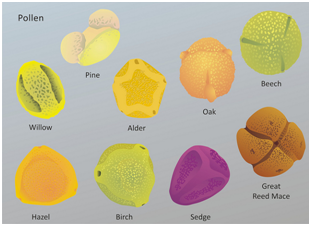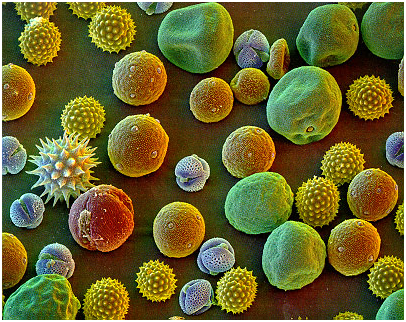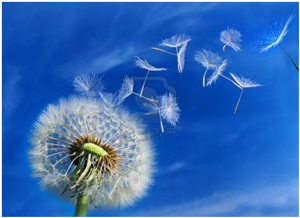Pollen



The primary culprits of pollen allergies are the plants that are wind pollinated. All of the trees and shrubs that cause spring allergy are wind-pollinated. Their flowers have been stripped down to the bare minimum and are often grouped together in long dangling structures (anthers) that expose the pollen grains to the wind. During pollination, the wind blows pollen off the anthers and carries it for various distances to land on some surfaces like soil, lakes, nose and eyes of humans.
Can you see a pollen grain?
Masses of pollen are visible to the naked eye on the end of a stamen of a tulip or other flowers. But the naked eye cannot distinguish an individual pollen grain; it is far too small.
How many pollen grains float through the air?
A typical tree will produce and release to the air roughly 2,000,000,000 pollen grains per season.






How long is the flowering season?
Trees flower in the springtime when temperature is increasing. For each type of tree, the flowering period is defined by specific conditions, which usually occur at approximately the same time each year, lasting roughly 2 weeks and the peak pollinating period (time when there are the maximum concentration of pollen in the air) lasting only a few days.
As a further complication, pollen concentrations in any flowering period vary on a daily basis in response to the various weather conditions. Pollen release is favourable on warm, dry, windy days whereas rain washes the air clean of pollen. Due to the biology of the plants, pollination usually occurs in the morning. Pollen concentrations are typically lowest at roughly 6 am increasing to the peak at 12 noon and decreasing through the afternoon and evening. See our Pollen Calendar for specific high risk times for different species of trees, grasses and weeds.
So what is it about pollen grains that make them allergenic?
When pollen grains are breathed into the nasal passages or contact the membranes of the eye, they release these proteins to the mucous membranes. This exposes the proteins to the immune system in the blood vessels of the mucous membranes.
The immune system is designed to rid the body of “foreign” proteins, and this usually occurs on a daily basis without any notice at all. However, for some people, for reasons that are still undiscovered, the immune system does not discard some of these pollen proteins through the usual route, but instead produces a special class of antibodies, IgE antibodies. The IgE antibodies bind to specialised cells called mast cells and upon contact with the pollen protein, signal the mast cell to release its contents.
One of the chemicals released in this process is histamine, which is responsible for producing the symptoms of allergy, e.g. swelling, redness, itchiness and secretion of mucous. All of these symptoms can occur when the immune system recognises one or more of these pollen proteins and produces IgE antibody to it. Some proteins are more likely to become allergenic than others, and some pollen types carry proteins that are more allergenic.
Pollen Avoidance
Allergen avoidance is difficult for people with allergy to substances in the air, such as pollen. For example, tiny pollen spores are windborne and travel for miles on air currents.




